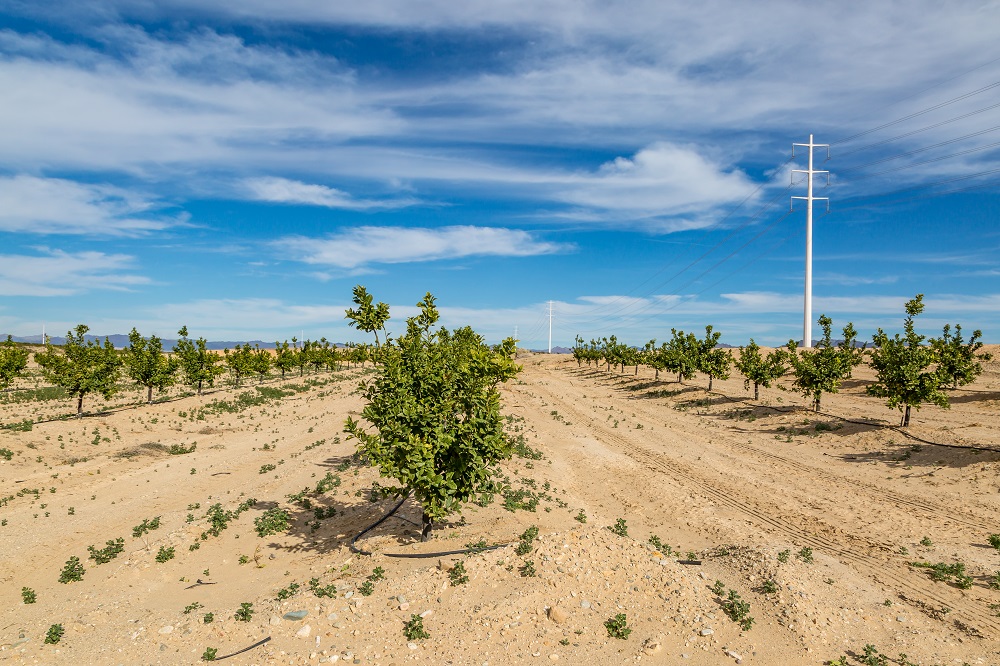
Electricity and water consumption play a crucial role in the sustainable development of desert regions. In countries with arid climates like the United Arab Emirates, water-energy efficiency and conservation in agriculture are critical issues.
Read Arabic story here
The Middle East is one of the most water-scarce regions in the world, accounting for 6.3 percent of the world’s population with access to only 1.4 percent of the world’s renewable fresh water. Food, energy, and water supplies are essential to life in every community, particularly those that rely heavily upon electricity and water infrastructures. In arid MENA countries like the United Arab Emirates, economic development results in increasingly intensive demands on energy and water resources, especially in the context of climate change.
One activity in the UAE that requires significant amounts of both water and electricity: agriculture. The areas suited to agriculture in the UAE are determined by the availability of water and cultivable soil, with groundwater the main natural source of water. Due to increasing food demand and rapid population growth, and the goal to achieve food security, the UAE has invested in the agricultural sector, potentially resulting in more stress on water and electricity resources.
To suggest policies for water-energy efficiency and conservation in the UAE, a team from Khalifa University in collaboration with MIT investigated the links between electricity and water consumption on UAE farms. Abdullah Khamis Banhidarah, recent KU graduate, Dr. Ameena Saad Al-Sumaiti, Assistant Professor of Electrical Engineering and Computer Science; Dr. James Wescoat Jr., Professor of Landscape Architecture and Geography at MIT; and Dr. Hoach The Nguyen, Postdoctoral Fellow, published their findings in Energy Policy.
Their analysis showed that water use is more important than electricity use in rural areas, with the cost and reliability of water more important than the cost and reliability of electricity.
“In rapidly urbanizing countries like the UAE, heavy emphasis is given to municipal, industrial, and urban resource uses, but we wanted to draw attention to the importance and nature of agricultural water and electricity use in the UAE,” explained Dr. Al-Sumaiti. “Two-thirds of all Emirates’ water consumption is taken by agriculture and agricultural water conservation is a matter of high priority for the UAE’s sustainable development. Understanding water and electricity use in agriculture can help increase efficiency and develop coherent usage policies.”
The researchers surveyed farms in the five different regions of the UAE, focusing on the variables that could explain the different levels of water and electricity use. They found that variables such as farm owner characteristics and farm worker salaries are associated with the levels of resource use. Gender, education level, and family visits to the farms in the winter influenced electricity consumption, while worker salary, the total number of palm trees, and the number of animals influenced water consumption.
“Interestingly, none of the farm owners reported that they are employing any renewable energy or distributed generation technologies, but they accepted the possibility of connecting to common water-electricity networks with other farms,” explained Dr. Al-Sumaiti. “Importantly, we also found that worker salary has a strong influence on both water and electricity consumption, meaning policies on water-energy efficiency should take this into account.”
There have been many changes to the UAE’s agriculture sector over the past few decades as the sector modernizes. These changes include the development of modern irrigation systems, organic farming, and hydroponics for plant growth with minimum water. Additionally, major efforts have been made to preserve water resources and harvest renewable energy, with the government focusing on sustainable usage and management of water and energy resources, particularly as the number of farms continues to grow.
In 2011, there were 35,704 farms in the UAE. The farms surveyed by the research team used the electricity distribution networks as their electricity source, but received their water from two sources, the water distribution network or water tankers, especially in remote areas where the distribution network is unavailable.
“All farms use water tanks for storage with an average of two tanks per farm and an average capacity of 2,740 gallons per farm,” explained Dr. Al-Sumaiti. “All the farms are grid-connected and pay monthly electricity bills. From surveying the owners, we found that the farms prioritize water cost and reliability over electricity, with relatively equal importance given to water usage for households, animals, and irrigation. These results indicate a strong rural pattern of resource preferences, and a recognition of water supply as crucial for farming sustainability.”
The researchers found five common factors affecting the consumption of both electricity and water: the farmer owner’s age, workers’ salary, farm owner’s visits to the farm in the summer, the number of buildings, and the number of rooms.
“The last two items are not too surprising, but the significance of the owner’s age and workers’ wages deserve further inquiry,” added Dr. Al-Sumaiti. “Additionally, gender, education level, and visits of the family to the farm in the winter influenced the electricity consumption in ways that need to be studied in relation to attitudes towards resource consumption and conservation. Less surprising is that income, total numbers of palm trees, and total numbers of animals affect water consumption. Farm water and energy budgets are a logical extension of this research.”
The team suggests that a variety of policies should be considered to achieve a significant effect on water and electricity consumption. Policies could aim at increasing the efficiency of water and electricity consumption, as well as developing isolated networks, micro-grids, and distributed generation to emphasize the benefits of technologies connected to other farms.
Jade Sterling
Science Writer
7 December 2021






